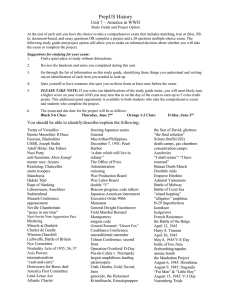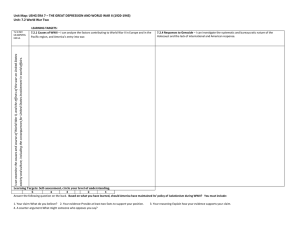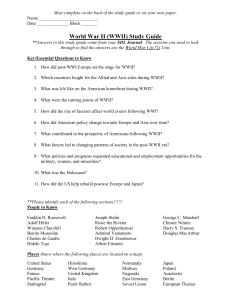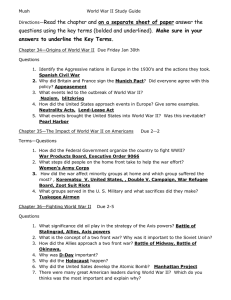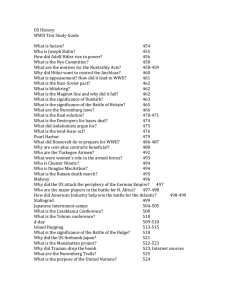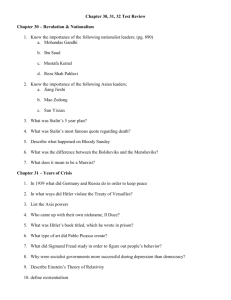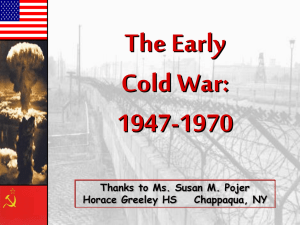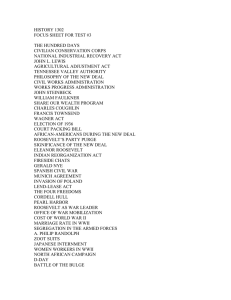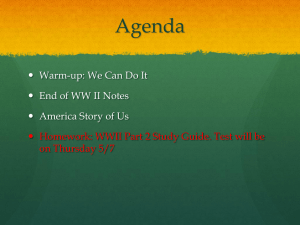Basic US History Unit 8 - WWII
advertisement
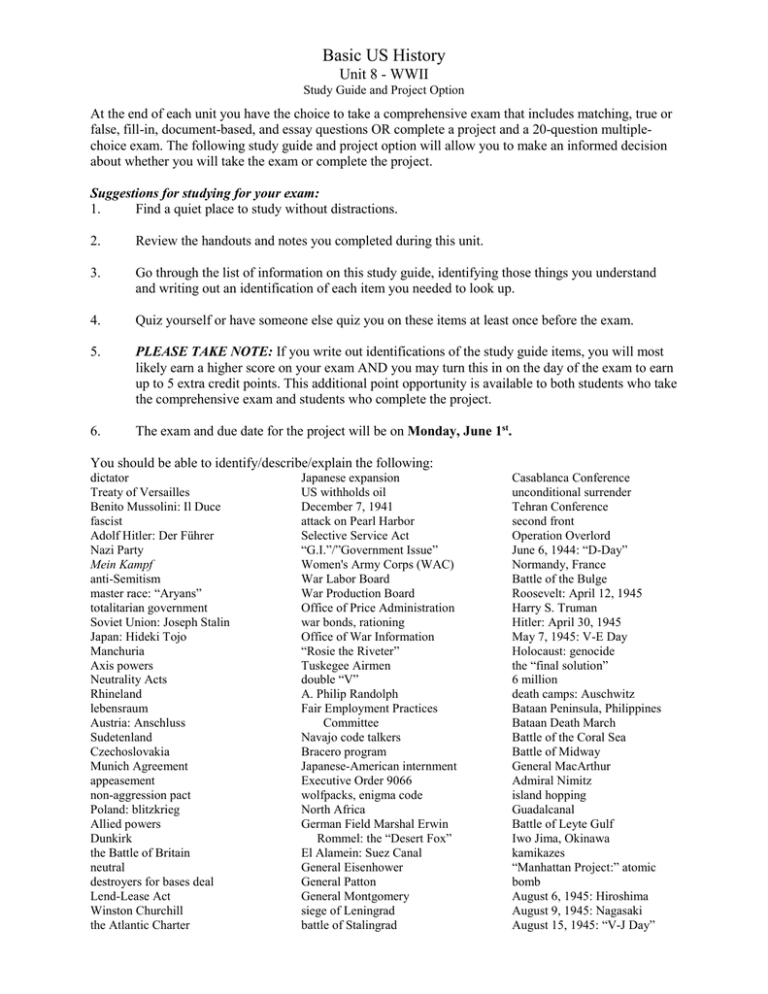
Basic US History Unit 8 - WWII Study Guide and Project Option At the end of each unit you have the choice to take a comprehensive exam that includes matching, true or false, fill-in, document-based, and essay questions OR complete a project and a 20-question multiplechoice exam. The following study guide and project option will allow you to make an informed decision about whether you will take the exam or complete the project. Suggestions for studying for your exam: 1. Find a quiet place to study without distractions. 2. Review the handouts and notes you completed during this unit. 3. Go through the list of information on this study guide, identifying those things you understand and writing out an identification of each item you needed to look up. 4. Quiz yourself or have someone else quiz you on these items at least once before the exam. 5. PLEASE TAKE NOTE: If you write out identifications of the study guide items, you will most likely earn a higher score on your exam AND you may turn this in on the day of the exam to earn up to 5 extra credit points. This additional point opportunity is available to both students who take the comprehensive exam and students who complete the project. 6. The exam and due date for the project will be on Monday, June 1st. You should be able to identify/describe/explain the following: dictator Treaty of Versailles Benito Mussolini: Il Duce fascist Adolf Hitler: Der Führer Nazi Party Mein Kampf anti-Semitism master race: “Aryans” totalitarian government Soviet Union: Joseph Stalin Japan: Hideki Tojo Manchuria Axis powers Neutrality Acts Rhineland lebensraum Austria: Anschluss Sudetenland Czechoslovakia Munich Agreement appeasement non-aggression pact Poland: blitzkrieg Allied powers Dunkirk the Battle of Britain neutral destroyers for bases deal Lend-Lease Act Winston Churchill the Atlantic Charter Japanese expansion US withholds oil December 7, 1941 attack on Pearl Harbor Selective Service Act “G.I.”/”Government Issue” Women's Army Corps (WAC) War Labor Board War Production Board Office of Price Administration war bonds, rationing Office of War Information “Rosie the Riveter” Tuskegee Airmen double “V” A. Philip Randolph Fair Employment Practices Committee Navajo code talkers Bracero program Japanese-American internment Executive Order 9066 wolfpacks, enigma code North Africa German Field Marshal Erwin Rommel: the “Desert Fox” El Alamein: Suez Canal General Eisenhower General Patton General Montgomery siege of Leningrad battle of Stalingrad Casablanca Conference unconditional surrender Tehran Conference second front Operation Overlord June 6, 1944: “D-Day” Normandy, France Battle of the Bulge Roosevelt: April 12, 1945 Harry S. Truman Hitler: April 30, 1945 May 7, 1945: V-E Day Holocaust: genocide the “final solution” 6 million death camps: Auschwitz Bataan Peninsula, Philippines Bataan Death March Battle of the Coral Sea Battle of Midway General MacArthur Admiral Nimitz island hopping Guadalcanal Battle of Leyte Gulf Iwo Jima, Okinawa kamikazes “Manhattan Project:” atomic bomb August 6, 1945: Hiroshima August 9, 1945: Nagasaki August 15, 1945: “V-J Day” Basic US History Unit 8 - WWII Multi-Genre Project Guidelines Background During the WWII era, many people created many different types of literature, art, and music and there were great changes in geography of Europe. Your task for this project will be to select examples of each of these genres (literature, art, and music) related to the WWII era. Content Find examples of each of the following from the WWII era: > a piece of literature (a poem, short story, folk tale, news article, etc.) > an art piece (painting, sculpture, mosaic, etching, etc.) > a piece of music (you must have a copy of the lyrics - but feel free to also include a recording!) > a map of WWII Europe labeled with major locations (see list in the format section below) can be printed in black and white or hand-drawn; must be colored by hand (not printed in color) Describe each piece in your own words: > What is it saying/presenting/describing? > How accurate is this (does it really describe what the WWII period was like)? > What is your personal opinion of the piece? Format Use complete sentences with correct spelling and grammar on all written pieces. Include a handwritten, signed, proofread copy of all written pieces. Be sure to list the author, artist, etc. and where you found each piece. Map must be accurate, colorful, at least 17 x 22, and include the following locations: Albania Germany Luxembourg Sardinia Austria Great Britain Mediterranean Sea Sicily Belgium Greece Moscow Spain Berlin Hungary Netherlands Sweden Bulgaria Ireland Normandy Beaches Switzerland Czechoslovakia Italy Norway Turkey Denmark Latvia Poland USSR Estonia Leningrad Portugal Warsaw Finland Lithuania Romania Yugoslavia France London Rome Due Date: Tuesday, June 10th Please Note: If at any time you are confused about what you’re supposed to be doing, please be sure to ask me, whether that means finding me at school or calling, texting, or emailing me (653-7828 - pam@pwags.org)! Multi-Genre Project Rubric includes a handwritten, signed, proofread rough draft Format (25 points) __√___ Possible Points _______ Points Earned____ suggestions made by proofreader evident in final copy __ 5___ _______ correct spelling, grammar, sentence structure, and word choice __10___ _______ map is accurate, colorful, at least 17 x 22, and includes all required locations __10___ _______ Content (75 points) literature piece is accurate to the era and thoroughly and accurately described __15___ _______ art piece is accurate to the era and thoroughly and accurately described __15___ _______ music piece is accurate to the era and thoroughly and accurately described __15___ _______ all pieces include thorough personal interpretation and comments __15___ _______ map accurately identifies the major civilizations & physical geography of WWII Europe __15___ _______ Total Points Earned on Project: 2 _______
